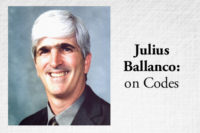My first engineering job was just a few blocks from Wall Street in lower Manhattan. At lunch, we used to walk up to Wall Street. Not to admire the financial institutions, but to get lunch. With all the money on Wall Street they had better lunch places nearby where you could get in and out quickly. In those days, engineers were only given 30 minutes for lunch.
You always could tell the Wall Street people from us young engineers. They seemed to run around with their heads cut off, eating quickly and getting back to the trading floor. As one friend who traded on the floor explained, “If you are gone for a minute, you could miss a big deal. You could lose $10,000.”
That is Wall Street. Everything happens in an instant. The response to any change has to show results at the end of the next quarter. If not, someone is going to lose a job. Unfortunately, Wall Street has rubbed off in many other areas of life. Within the last 25 years, there has been a loss of patience. Results are expected instantly.
This also seems to be happening in the engineering profession, as well as the codes and standards part of the profession. Results are expected instantly. Yet, in our profession results happen slowly — as in years, not weeks. We cannot show fantastic quarterly changes.
This has been especially frustrating within the discussions of global warming or climate change. Call it what you want, the political side of the discussion has turned bizarre. Political leaders expect results instantly. It is upsetting that some in the engineering community make such outlandish promises to appease elected officials and pundits.
The news media was quick to report 2015 was the warmest year on record. Come on, we have only been recording weather for a little more than 100 years. Go back more than 75 years ago and our measuring techniques weren’t the greatest. But using Wall Street mentality, everyone jumped on the issue.
Setting the tone
I like to think back to my days as a young engineer. I started a few years after the first Earth Day. That first Earth Day meant a lot to me, not because I was going into engineering but because I was an Eagle Scout. All my classmates and fellow Boy Scouts supported Earth Day and the efforts to clean our planet.
If you think back to those days, not too far from where I was living at the time was Bethlehem, Pa., the home of Bethlehem Steel. In the 1960s, the city seemed to always be in a black cloud from all the pollution from the mills. Thanks to Earth Day a new agency was formed called the Enviromental Protection Agency. I am very proud of how the engineering community responded by cleaning up the air and water pollution.
Look at Bethlehem today. It is a clean city where you can breathe clean air all the time.
I could go on to mention all the polluted rivers that are now clean with fishing and recreational activities returning. All of this is the result of the engineering community.
But unlike Wall Street, we knew it would take time. We knew what we had to do. We also invented new ways of doing things to create less pollution. It was not the politicians who cleaned the Earth, it was the engineering community. We applied the knowhow and technology, but we knew it would take time.
As soon as we buy into the Wall Street mentality, we might have another Mount Tambora or Krakatoa volcano eruption. Then all bets are off for instantaneous change. These two natural occurrences screwed up the weather for years, respectively. After Mount Tambora it was reported the farmers in the United States couldn’t grow anything the following year. Of course, volcanic eruptions are not manmade, but they show the need to be patient. Protecting the Earth doesn’t happen overnight.
Paper trail
I will admit to being frustrated with all the media discussions on climate change and global warming. Why can’t we just continue to talk about the need to protect the Earth? Why can’t we continue to clean the air, the water and the environment? Why do we need Wall Street headlines? I keep thinking about a line popularized in the 1976 film, “All the President’s Men.”
“Follow the money.”
It sometimes appears there is more interest in money for research, advocacy, etc., than a desire to simply protect our environment.
Many of my non-engineering friends will ask me what I am doing about climate change. They see my face contort as I find a polite way to respond. Rather than taking the bait, I simply tell them that the engineering community has been cleaning the Earth for the last 50 years. We will continue to reduce pollution, find new clean energy sources, increase efficiencies, and on and on. Then I finish with, “It takes time. We move forward in the engineering profession, not backward.”
If you look at the last 50 years in the codes and standard profession, we have made huge strides. Fifty years ago the only buildings that required sprinklers were large storage or industrial buildings. Even a high rise could have been built without sprinklers.
Today, it is rare to find a building that is not sprinklered. If you look at the record, fire deaths have dropped significantly because of the action taken in the codes all those years ago.
On the plumbing side, lead contamination through drinking water is down to next to nothing. We have the highest water quality in the world. Hazardous waste is being treated onsite without doing damage to the treatment plants. Grease removal has significantly improved.
Mechanical code changes are even greater. Fifty years ago a boiler was considered good when it had an efficiency of 60%. Today, we have boilers with better than 90% efficiency as the norm. Ozone-depleting refrigerants, which were the only refrigerants used for comfort cooling, have disappeared from the marketplace. The industry is currently gearing up for the newest low global warming potential (GWP) refrigerants to hit the market. But that is still a few years away.
Engineers have to do away with the Wall Street mentality. It won’t happen in the next quarter. Changes go through the normal engineering analysis. We simply need to continue to do what is right.
As a profession, we cannot rest on our laurels. We need to see the future and move in that direction. Our goal should always be the highest level of protection of public health and safety.
This article was originally titled “Avoiding the Wall Street mentality” in the March 2016 print edition of PM Engineer.




